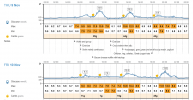gogobroom
Well-Known Member
I've just started using my Libre GCM and trying to get a handle on what the numbers mean, I am currently trying to go lower carb (under 100gsm a day, previously was about 160) started off with breakfast with a carb content of 12g = no considerable rise in BG at 8.09 this morning (reading was already high at 8mmol, by 10.13 there wasn't much change at 7.9 at this point I ate an apple, circa 16g carbs, within an hour my reading had gone up to 10.2, and was still over 9 at midday - where I went for a run, post run back down to 7.7.
What I am trying to understand is why after the apple it rose by 2mmol when I thought that an apple was unlikely to cause a BG rise ? Does this seem normal or correct ? Double checked with finger pricks and readings about the same.
For info my usual morning FBG reading is between 7 and 8 currently
Any insight will be helpful Thanks
What I am trying to understand is why after the apple it rose by 2mmol when I thought that an apple was unlikely to cause a BG rise ? Does this seem normal or correct ? Double checked with finger pricks and readings about the same.
For info my usual morning FBG reading is between 7 and 8 currently
Any insight will be helpful Thanks



